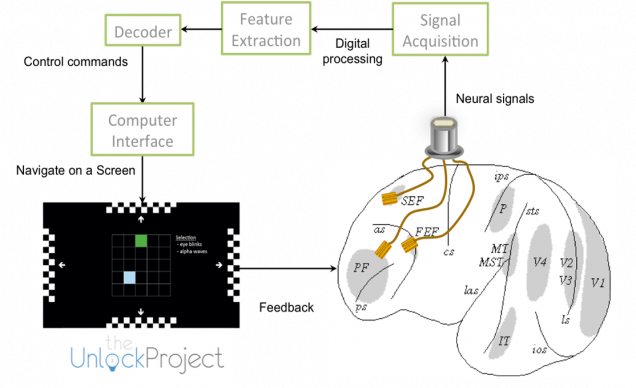An Eye Movement Brain-Computer Interface
In this collaborative project with the Miller lab at MIT, we developed one of the first eye movement brain-computer interfaces using electrodes implanted in monkey frontal cortical areas involved in eye movement planning and execution. The BCI decoded intended eye movement direction from the neural activities recorded from three 32-channel planar electrode arrays that were permanently implanted in the supplementary eye field (SEF), frontal eye field (FEF), and prefrontal cortex (PFC) of two non-human primates. The system was capable of correctly decoding intended saccade direction in approximately 80% of trials involving 6 possible movement directions. In other words, the system successfully produces “virtual eye movements” to targets on a computer screen without requiring overt movement on the monkey’s part.

Eye movement brain-computer-interface (BCI) block diagram.
Publications
- Jia, N., Brincat, S.L., Salazar-Gómez, A.F., Panko, M., Guenther, F.H., and Miller, E. (under review). Decoding of intended saccade direction in an oculomotor brain-computer interface.
- Brincat, S., Salazar-Gomez, A.F., Jia, N., Panko, M., Miller, E.K., and Guenther, F.H. (2013). Development of an intracortical eye movement-based brain-computer interface. Proceedings of the 2013 International BCI Meeting, Pacific Grove, CA.
- Brincat, S., Jia, N., Salazar-Gomez, A.F., Panko, M., Miller, E.K., and Guenther, F.H., (2013). Which neural signals are optimal for brain-Computer interface control? Proceedings of the 2013 International BCI Meeting, Pacific Grove, CA.